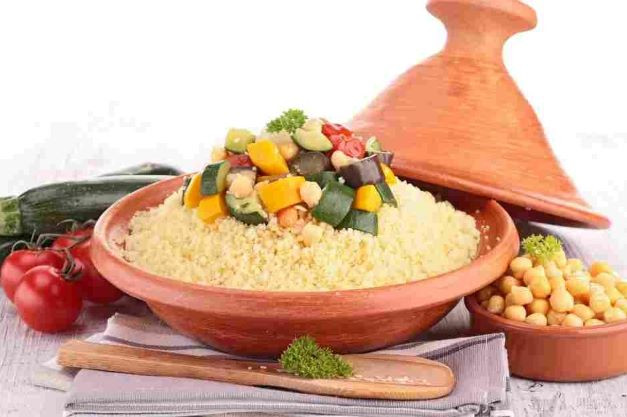Couscous made with rice – ideal for people on a gluten free diet!
Posted by Spice Zen on 18th Jan 2022
Couscous is a kitchen staple in North Africa, the Middle East, and the Mediterranean region. It is made from husked and crushed semolina of Durum wheat or other grains like rice, millet, corn or barley. The national dish of Morocco, it is an expression of love, celebration, happiness and generosity. This blog explores why this humble food has become a go-to dish for so many. While traditional couscous has gluten, Spice Zen's Rice Couscous can be enjoyed even if you have gluten intolerance or are Coeliac.
The origin of couscous is still ambiguous. According to Lucie Bolens, a food historian, ethnic Berbers in North Africa may have been cooking couscous around 238 to 149 BC. Charles Perry believes that couscous originated in North Africa between the end of the Zirid dynasty and the rise of the Almohadian dynasty, sometime between the 11 th and the 13th centuries. It is acknowledged as a traditional North African dish for all occasions. UNESCO placed Couscous on the world’s Intangible Cultural Heritage list in 2020.
Couscous (pronounced as kūs-kūs) is derived from the Berber word seksou or kesksu, meaning well rounded. Durum wheat is the most popular grain to make couscous. Berber tribes of North Africa have different names for couscous. The local name for different types of couscous dishes varies for coarse or finer grain couscous and couscous from other grains like barley (Malthuth), millet or rice. Ibn Battuta, a Berber Maghrebi explorer and writer, mentions rice and millet couscous in the area of Mali in 1350.
Traditionally, couscous is prepared by steaming the semolina granules multiple times over stews in a couscousière. A couscousière is a set of two interlocking pots. The larger bottom pot is for cooking broths, stews or soups or filled with water, while the smaller upper pot has a perforated base with a lid. It is a ritual of moistening the semolina granules with water or oil, steaming, kneading, mixing with butter and repeating the process till the couscous is light and fluffy!
The commercially available couscous is generally pre-cooked and dried. It is like an ‘instant couscous’. If you cook it using the traditional process, it will result in a mushy couscous dish. Some speciality stores stock the authentic uncooked couscous granules.
In Morocco, Tunisia, Algeria, Mauritania and Libya, couscous meal is usually served, with meat (chicken, fish, lamb or mutton), vegetables and chunky ‘Harissa’ sauce. Other spices like Ras-el-Hanout or fenugreek are also popular.
There is often a discussion whether couscous is a grain or a pasta. Some believe that it is a type of grain and others think it is pasta, as it is made from the same type of durum wheat flour. In our view, traditional couscous granules are different to pasta as they are made from small semolina granules – the hardest part of the grain that resists milling and not from the flour like pasta.
Gluten-free Rice Couscous
Spice Zen’s Rice Couscous is an artisanal, stone ground, certified organic, gluten-free product made from rice semolina. It is endorsed by Coeliac Australia. They come in two options – White Rice Couscous (made with lower GI, Basmati rice) and Brown Rice Couscous (made with Quick Cook, Brown Basmati Rice).
The rice grains are sorted, roasted and stone-milled. Then they are sieved to remove the flour and the process is repeated till the desired semolina granule size is achieved. When we sieve it, the sound of ‘ksa ksa’ made us realise why it is called ‘couscous’!
It is a perfect alternative to wheat-based couscous for people with gluten intolerance or coeliac disease. It is a unique, smart product that combines the authenticity of traditional couscous and the convenience of ‘instant couscous’.
Cook the gluten-free rice couscous as a savoury or sweet dish for any time of the day - breakfast, lunch, dinner, a healthy snack or lip-smacking dessert. You can cook gluten-free rice couscous in a microwave, on a stovetop or in a couscousière. Serve it with various dishes ranging from stewed vegetables to chicken, lamb, or mutton. If you want to try something creative, add toasted almonds, raisins, peas, chickpeas, dried fruits or a compote of fruits to cook couscous and enjoy. You can also add cooked couscous to the salads after chilling them.
Creative cooking with Rice Couscous
Rice Couscous cooks similarly to a regular wheat-based instant couscous. Wondering how to add a twist to regular rice couscous? Try MasterClass, tips of creative dishes that you can cook with couscous and substitute rice couscous for the regular couscous:
1. Vegan Couscous
Prepare a vegan couscous dish by replacing meat broth with vegan vegetable broth. You can also use water seasoned with salt, black pepper, ginger, garlic, and spices or add Spice Zen’s Ras-el-Hanout or Harissa blend. Add olive oil instead of butter. Serve with a vegetable stew made with eggplant, zucchini, carrots, squash and tomato.
2. Couscous Salad
Mix cold cooked couscous with diced onion, carrots, capsicum, sweet potato, pumpkin, Italian Herb Blend, cherry tomatoes, and cucumber to create a picnic dish or a lunchbox-friendly salad. Garnish with chopped parsley and serve it as a side dish or mains.
Check out Spice Zen’s Rice Couscous Salad Recipe!
3. Sweet Couscous Pudding
Add almond milk or orange juice to couscous made with plain hot water. Then season it with cinnamon, sugar, orange zest, and top off with nuts and dried fruit.
4. Crispy Couscous - Tahdig
Prepare one cup of couscous using your preferred method and heat olive oil or unsalted butter in a medium non-stick pan. Once the butter melts, turn the heat down to low and add couscous. Add a simple tomato sauce and using the back of a spoon, press it into the pan evenly. Cover the pan and steam for an additional 10-12 minutes, or until edges are lightly brown, and flip onto a plate. Your crispy couscous is ready to enjoy!
Now that you know about the different ways to cook with rice couscous, why don’t you go ahead and try these simple recipes yourself with either white rice couscous or brown rice couscous ?
Spice Zen Spice blends that complement couscous dishes are:
Spice Zen’s products are 100% certified organic and gluten-free. They do not contain any added preservatives or flavourings. They are suitable for people with gluten intolerance, coeliacs and those following a gluten-free diet.
Check out our stone ground, gluten-free, rice based couscous, semolina, and flour collection here. For more information, visit our website.




